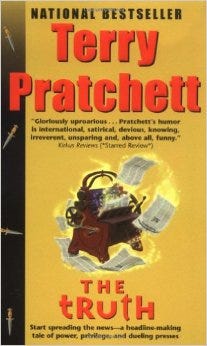So What, Who Cares (volume 1, issue 22) When did it get trendy to sandbag the Gray Lady?
Happy Thursday night/Friday morning to you all. This is the second day of my "Do email clients hate knowledge?" test & I'm curious to see how quickly this email finds you. Feel free to let me know when you get it via email or Twitter. And a big thank-you to all of you who were kind enough to take the time and let me know about yesterday's edition.
*
So recently, I've noticed an interesting feedback loop among A-list media outlets: The New York Times publishes something and within days, someone else at another outlet has written a blog post pointing out that the initial article was fatuous/misguided/poorly sourced. Behold the following examples:

The New York Times writes: "For a fascinating, if imperfect, way to measure the spread of food trends, we came up with a list of trendy ingredients and dishes of a generation ago and today, and put the Times Chronicle to work to see how frequently those terms appeared in our pages." (8/12/14)
And The Atlantic's Citilab replies: "The entirety of all of the data for these trends is based on mentions in The New York Times. All of it. Transparently, yes … Which made me wonder, what other trends did The New York Times start? Using the same database of articles, I did a few analyses of my own. It's interesting to see how pants really took off around 1970, lulled in the early 1980s, and really came into their own in 2010." (8/18/14)
OR ...
The New York Times writes: "Over the last few decades, residents of many traditionally liberal states have moved to states that were once more conservative. And this pattern has played an important role in helping the Democratic Party win the last two presidential elections and four of the last six." (8/23/14)
And Fivethirtyeight replies: "People who leave an area don’t necessarily resemble the ones who stay. Instead, there’s evidence that migrants’ political beliefs mirror those of voters in their new destination. Many people moving from a liberal state to a conservative state may be conservative, or may at least end up that way before long." (8/29/14)
OR ...
The New York Times writes: "Portland’s paradox is that it attracts so many of “the young and the restless,” as demographers call them, that it has become a city of the overeducated and underemployed — a place where young people are, in many cases, forced into their semiretirement." (9/16/14)
And Citylab replies: As Portland State University researchers Greg Schrock and Jason Jurjevich have shown, far from retiring, young and talented people coming to Portland are decidedly entrepreneurial. On average, they’re 50 percent more likely to start their own businesses. And Portland ranks third nationally among large metro areas in the fraction of its college-educated young adults running their own businesses. (9/17/14)
So what? Recently, The Dish's Alex Pareene issued a broadside against much of what passes for web content or journalism these days, arguing against quick takes on the news are "ephemeral, aggregated and feather-light," and then elaborated that the evils of Web content include such quick-hit blog posts as aggregation, viral bilge and Reddit-chasing. (Though there's some suggestion that the days of aggregation as a growth strategy are drawing down.)
It is possible we're looking at another emerging content category: "The New York Times got some attention with their piece, so let's see if we can get in on that action."

A less cynical take is this: news coverage benefits from sustained attention to a topic or story, and in this hyperlinked era, no one publication owns coverage on an issue. So isn't it great that we can add to the coverage with our own in-house expertise?"
Daisy-chaining coverage is actually not a bad thing for either the media or for readers. But it depends on how readers are receiving these point-counterpoint pieces -- are they seeing them as a chance to review many sides of a topic with multiple data points, or is the argument going to be, "Clearly, the New York Times is addlepated or else nobody would contest their coverage?"
Who cares? A lot of reporters and editors -- and audience development folks, no doubt. With the decline of the homepage, a lot of news traffic is being driven by social sharing. And while the data about what readers connect with is valuable, it also brings to mind the deathless insight the Patrician delivered in Terry Pratchett's The Truth: "People don't want News. They want Olds." So the social sharing -- for which the Point/Counterpoint format of journalism is tailor-made -- may also affect news coverage because it could influence what pieces deserve rebuttals or elaborations -- and what subjects remain unexamined despite their importance.
*
Okay! Your light-hearted video of the day features a cat with poor depth perception. Sail! If you really like this newsletter, tell a friend to subscribe.

